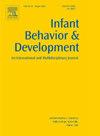Goal saliency and verbal information influence the imitation of movements and goals in 20-to 22-month-old toddlers
IF 1.9
3区 心理学
Q3 PSYCHOLOGY, DEVELOPMENTAL
引用次数: 0
Abstract
Previous research has suggested that infants and toddlers prioritize the imitation of goals over movements, but recent evidence revealed a more flexible pattern of imitation that depended on the visual saliency or efficiency of movements and goals. This study investigated how visual saliency of action goals alongside verbal information influences toddlers’ action processing and imitation. Twenty- to 22-month-old toddlers observed a toy animal being moved in a particular style toward one of two goals. Goals were either two-dimensional drawings or three-dimensional objects. Before the demonstration, the experimenter provided verbal information about the movement style for one group of toddlers, and about the goal for the other group. Toddlers’ imitation was influenced by goal saliency, verbal information, and an interplay of these factors. Toddlers preferred to imitate the goal over the movement in the 3D condition, and the movement over the goal in the 2D condition, revealing that goal saliency influenced imitation preferences. The effect of verbal cues depended on the order of saliency conditions. Verbal cues impacted imitation only in toddlers who participated in the 2D trials first, indicating that toddlers might be especially susceptible to verbal cues when initial visual information is less salient.
目标显著性和言语信息对20 ~ 22月龄幼儿动作和目标模仿的影响
先前的研究表明,婴幼儿对目标的模仿优先于动作,但最近的证据显示,一种更灵活的模仿模式取决于动作和目标的视觉显著性或效率。本研究探讨了动作目标的视觉显著性和言语信息对幼儿动作加工和模仿的影响。20到22个月大的幼儿观察到一个玩具动物以一种特定的方式朝着两个目标之一移动。目标要么是二维的图纸,要么是三维的物体。在演示之前,实验者向一组幼儿提供了关于动作风格的口头信息,并向另一组幼儿提供了关于目标的口头信息。幼儿的模仿受到目标显著性、言语信息和这些因素的相互作用的影响。幼儿在三维条件下更倾向于模仿目标而不是运动,在二维条件下更倾向于模仿运动而不是目标,这表明目标显著性影响了模仿偏好。言语提示的效果取决于显著性条件的顺序。言语暗示只对先参加2D实验的幼儿有影响,这表明当最初的视觉信息不太明显时,幼儿可能特别容易受到言语暗示的影响。
本文章由计算机程序翻译,如有差异,请以英文原文为准。
求助全文
约1分钟内获得全文
求助全文
来源期刊

Infant Behavior & Development
PSYCHOLOGY, DEVELOPMENTAL-
CiteScore
4.10
自引率
4.80%
发文量
94
期刊介绍:
Infant Behavior & Development publishes empirical (fundamental and clinical), theoretical, methodological and review papers. Brief reports dealing with behavioral development during infancy (up to 3 years) will also be considered. Papers of an inter- and multidisciplinary nature, for example neuroscience, non-linear dynamics and modelling approaches, are particularly encouraged. Areas covered by the journal include cognitive development, emotional development, perception, perception-action coupling, motor development and socialisation.
 求助内容:
求助内容: 应助结果提醒方式:
应助结果提醒方式:


